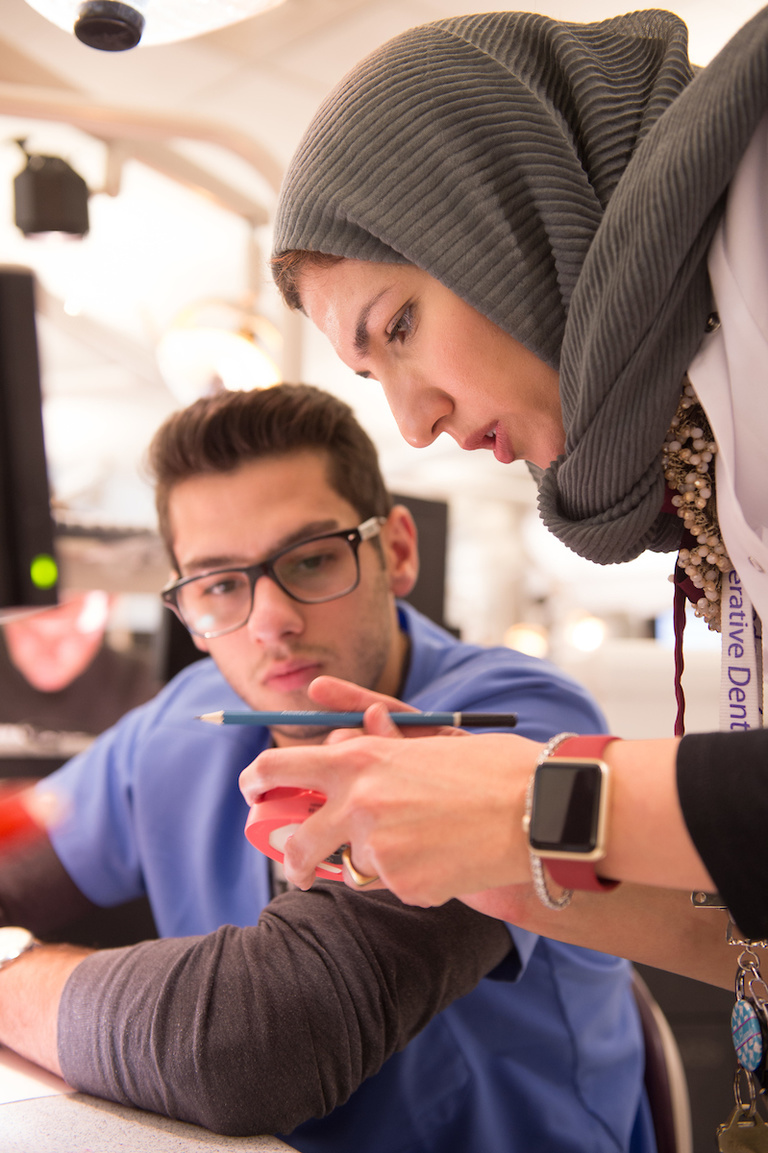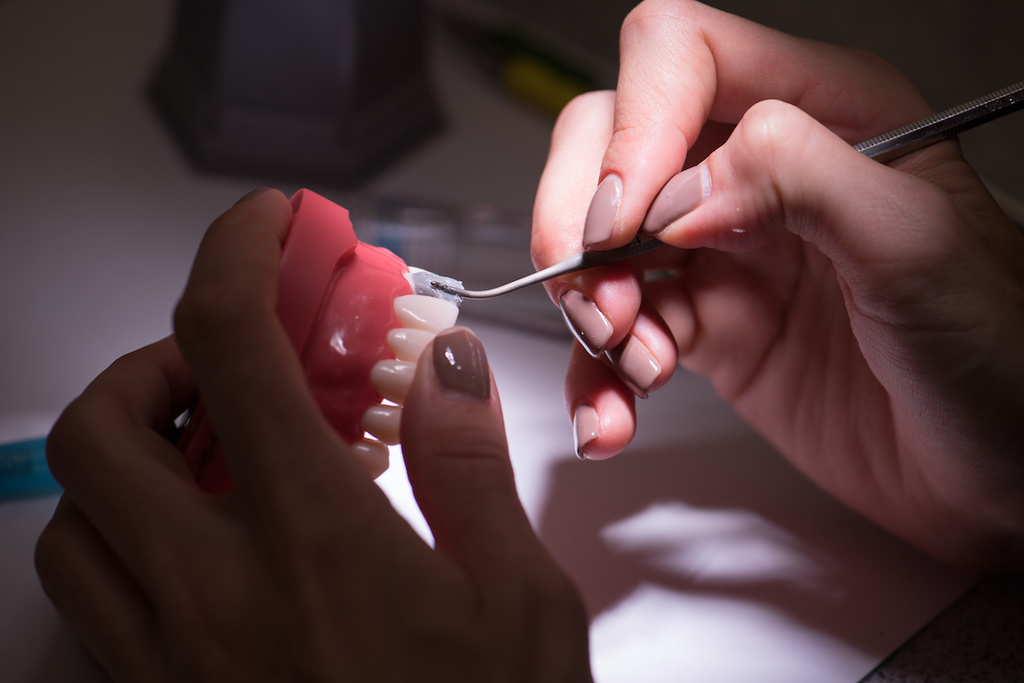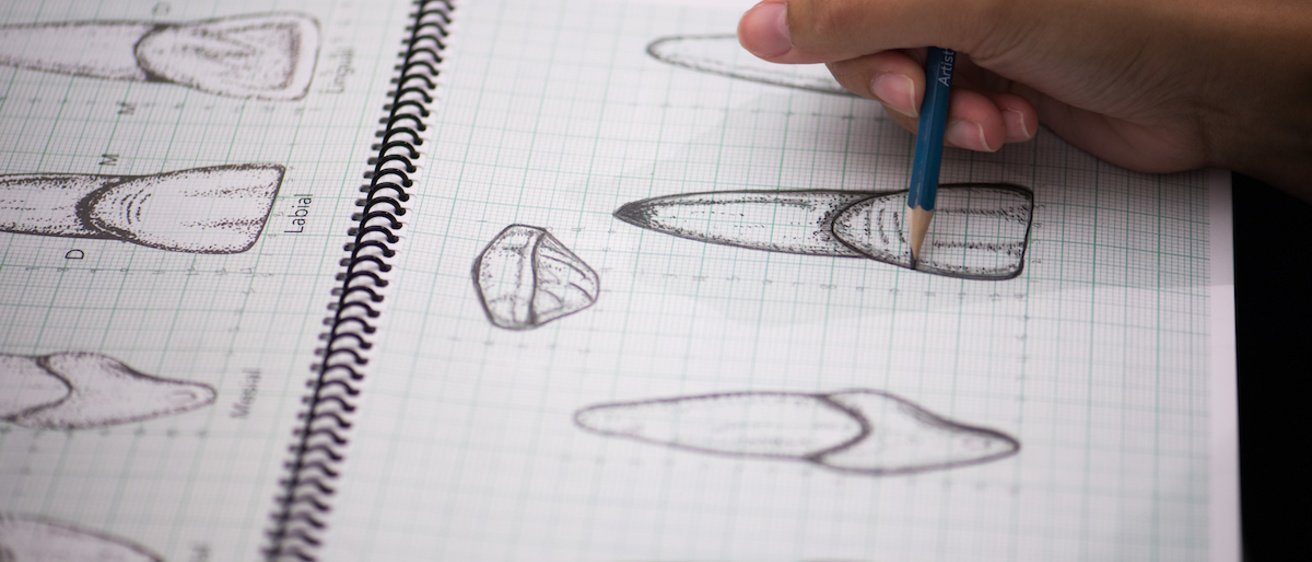Dentistry students at the University of Iowa are getting a new perspective on teeth—including the importance of the jagged ridge of a premolar and the graceful interior slope of a central incisor—as part of a tooth anatomy art lesson that aims to strengthen dental skills by improving students’ manual dexterity and visual aesthetic.

The anatomy art lesson requires students to carefully study tooth shape and dimension in order to create intricate drawings and, later, realistic wax tooth models. Taught as part of the mandatory Tooth Anatomy course for all first-year dental students, the art lesson was created by College of Dentistry professor Hanan Elgendy, who says she wanted to develop students’ artistic skills and push them to explore the important mélange of science and art in dentistry.
“In order to restore a broken or missing tooth, a student must understand the biology of oral health, but they must also understand the natural tooth morphology they are recreating,” says Elgendy. “This exercise imprints this concept in their minds.”
Elgendy started the art lesson a year ago, and although there were some groans and eye rolls at first, students quickly saw the value of the assignment and worked hard to produce pencil sketches that, for amateurs, were shockingly intricate, even beautiful.
Feedback from students—many of whom never expected to be drawing in dental lab—was positive overall, with many of them thanking Elgendy for opening their eyes to a tooth’s subtle curves, ridges, points, and depressions.
“I thought the drawing assignments helped enhance my ability to identify important anatomical characteristics of teeth,” says Riley Gray, a second-year dental student from West Des Moines, who took Elgendy’s course last year.
“The drawings were a great way to understand the line angles and point angles of the teeth,” says Cody Glass, a second-year dental student from Lancaster, Wisconsin, who also took Elgendy’s course last year. “Drawing was fun and a low-stress way to learn.”
When Elgendy was growing up in Egypt, she enjoyed drawing and art in general, but when it came time to enter the university, she says her parents encouraged her to study medicine or dentistry. She followed their advice, but has always wanted to find a way to combine her love of dentistry with her love of art. When she came to the UI in 2013 to work in the college’s Department of Operative Dentistry, Elgendy says she decided to introduce the idea of an anatomy art course to her supervisor, who was intrigued and eventually granted approval.

Now in her second year teaching the Tooth Anatomy art lesson, Elgendy says she has observed improvements in the way students make wax models of teeth, which in turn helps them create more realistic dental restorations and tooth replacements. Dental restorations and tooth replacements must be carefully crafted—and with an artist’s eye—or they will not look real in a patient’s mouth. Elgendy says she hopes to continue tracking students’ progress in this area and to eventually produce research papers to establish the correlation between strong dental skills and early tooth morphology learning, including her art lesson.
Elgendy says she knows of only one other dental school in the nation that incorporates tooth drawings into early dentistry education.
“My main goal is to improve students’ understanding of tooth morphology, develop their dexterity and translate this into improved clinical skills,” Elgendy says. “I think my research will prove that first-year students who study tooth anatomy through drawing will develop better perceptual skills, and that they will be better dentists.”
At a recent session of her anatomy course, Elgendy observed as students used graphite pencils to shade and define their tooth drawings. The large lab space was quiet as students concentrated on their art work. From time to time, a pair of students would take a break from their work to compare designs or chat about sketching techniques to improve a realistic outcome.
Emma Miller, a first-year dental student from Cedar Rapids, Iowa, says she “had no idea that teeth were so complex.”
“I just didn’t realize that they had so many grooves and points and ridges,” she says, still crouched over her drawing. “I’m not an artist at all, so at first I was nervous, but I do feel like I can visualize the shape of the tooth better now having done the drawing.”
After finishing her drawing, Miller moved on to her wax model project, in which first-year students use small Bunsen burners to melt wax and apply it to a plastic stub. As they add more hot wax, they build up the tooth, shaping and smoothing the wax as they go. When the wax tooth is finished, it will receive a grade and perhaps be further perfected, then finally used to make a mold for a false tooth.

“The drawing project has definitely helped me understand the curve of the upper third of the tooth,” says Brady Ellis, a first-year dental student from Colfax, Washington. “I like drawing, so this assignment is fun for me, but it’s also a good way to take the learning out of a book and make it real. I think I’ll remember this better than if I was just reading about teeth in a text book.”
Elgendy’s supervisor, Steven R. Armstrong, professor and chair of the College of Dentistry’s Department of Operative Dentistry, says it’s important to look for new ways to help students learn and succeed, and that the artwork course is a good example.
“Dr. Elgendy is building on the College of Dentistry’s long history of educational excellence by providing cutting-edge teaching materials and striving to continually improve the learning process,” he says. “The ability to replace lost tooth structure to the original tooth morphology is essential for optimal chewing, healthy gum tissues and, of course, a beautiful smile, and that’s what we want our students to do, go out and create beautiful smiles.”
